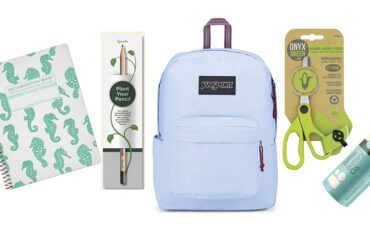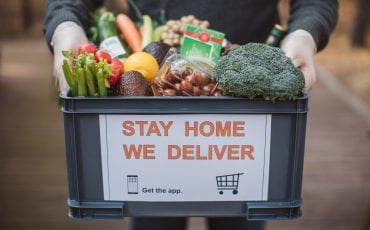Cooking Up Savings: How to Make the Most of Your Food Budget
If the recent rising prices have you rethinking your money-spending habits, one great way to start saving more money is by eating more meals at home. But be aware that inflation has affected the cost of groceries, too! So how can you be smarter about spending your hard-earned cash and saving yourself from food mishaps? Here are five areas in which you can be savvier in the kitchen.
Table of Contents
Save on Groceries
Grocery shopping can rack up a big bill, but making your own meals at home will get you the most bang for your buck. Start small — you can incorporate more of these tips as your shopping habits become more natural.
Before You Go
“Make a plan,” says Katherine Shary, a licensed dietitian at Children’s Healthcare of Atlanta’s Strong4Life. “It’s definitely an age-old tip, but by making a plan, you know what to buy at the grocery store, so you’re not grabbing items that are going to add up at checkout. By sticking to that plan, you can save money. You might have to do a little meal prep, but it doesn’t have to be for a full week.”
To start, plan meals for two days out of the week, and create a list for your grocery store visit. Planning your meals and sticking to a list will keep you from splurging on unnecessary items. You also won’t have to return to the store to pick up items you forgot.
Before you head to the store, do your homework to compare savings at different grocery stores to find the best deal. “Look at store ads and compare prices,” Shary says. “You’re going to get the best bang for your buck at those stores that have sales compared to going to one store.”
Try to plan your meals around sales items. Shop BOGO deals, and stock up on items your family is more likely to go through quickly. But don’t buy items you won’t eat just because they’re on sale! It’s not a deal if your family will waste it.
Consider signing up for loyalty programs at the store you visit the most for extra savings. “They’ll often offer discounts, and those can be really helpful,” Shary says. And, consider shopping at irregular times. If it’s less crowded and you feel less rushed, you’re more likely to take your time browsing items to find the best price. If you can, try to visit the grocery store less often. Shopping less frequently cuts down on travel costs and encourages you to use up what you already have at home.
If you’re not sure how much you usually spend on food, it can be helpful to go over your expenses from the last couple of months. You may be the type of person who is more likely to stick to your goals if you have help, so consider downloading a budgeting app to hold yourself accountable.
While You Shop
Peruse the store smartly and don’t be brand loyal. Usually, the most expensive items are at eye level or at the end of the aisles to capture your attention. The top and bottom of the shelves often hold the cheaper items or showcase the grocery store’s version rather than the name brand. Beware of impulse shopping or browsing the aisle at the checkout line. And don’t shop on an empty stomach, as you’re more likely to make impulse purchases! Consider eating less meat, as meat has seen the highest price increase. “Try meatless meals,” Shary says. “Cooking meatless meals 1-2 times a week is typically less expensive, as those protein sources — beans, lentils, tofu — cost less than buying meat and poultry, which can help you save money.”
“We do tend to fall into certain marketing traps with buzzwords, such as natural or organic. We start to think that those are the only foods we should buy to eat healthy,” Shary says. “Frozen and canned fruits and vegetables are just as healthy and contain all the same nutrition. They still contain the vitamins and minerals we need.” Canned and frozen produce are often cheaper than fresh produce and will last longer in the pantry or freezer.
Shop locally grown, in-season vegetables at a farmers’ market. Produce will be fresher and more affordable than out-of-season items. “Organic simply means the food has been produced without pesticides,” Shary says. “But it takes a lot for farmers to get that recognition. So, while it might not have the label, shopping at your local farmers’ market or stand will get you the same great produce. There’s nothing wrong with purchasing organic, but it’s also OK to eat foods that are not organic.”
“When buying frozen entrees, think about balanced plates,” Shary says. “With frozen pasta or pizza, think about what your whole meal will look like. What are you going to have as a side? Microwave frozen green beans or bring out a can of peaches, so you have a more well-rounded meal that’s filling for your family while being convenient.”
Compare prices on items. “Try not to buy individually cut fruit. That’s often much more expensive than buying a full pineapple and cutting it yourself at home,” Shary says. “You’re paying the store for its labor. The same goes for snacks — it’s better if you buy the regular bag as opposed to buying individual snack packs.” Items like pre-shredded cheese also may cost more due to convenience.
Shopping the deli or buffet bar may be tempting, but food is usually more expensive than buying the ingredients to make the recipe yourself. Also, pay attention to sizes. The price per unit may differ, but you’re getting more bang for your buck in the long run. Calculate unit price at unitpricecalculator.com.
At Home
The meals you cook also don’t have to be difficult. “We think we have to cook everything from scratch and give our family fancy meals,” Shary says. “It’s a financially friendly, filling and healthy meal to have a sandwich night. Make PB&Js, have a fruit cup on the side and serve milk. It’s not a fancy meal, but it’s filling and family friendly. You can also plan semi-homemade meals. Make your main dish but get help with your side dishes by serving frozen veggies or canned fruit.”
Bad day at work? We’ve all been there! Have convenient meals on hand. That way, when your day is done, you’ll be less tempted to order from a restaurant and spend the extra money. Some ideas to keep on-hand are frozen ravioli, lasagna or pizza; premade pasta or rice; bags of salad; canned soup or beans; frozen fish or chicken.
Involve your family. If your children love food, make eating at home a source of pride for them by involving them in the planning and cooking of the meal, so they can feel accomplished. If they’re disappointed to be eating out less, make the at-home meal feel special by using decorative plates or fun décor to upgrade your dining room to feel like you’re at a new restaurant.
“Eating at home allows us to know what’s in our food,” Shary says. “Making 2-3 dinners can contribute to health, and not just because of the food. Eating together as a family, putting the screens away and enjoying each other’s company is also a health benefit. Eating at home is great, and maybe it can’t happen all the time, but that’s OK. Make those meals family time, where everybody can enjoy the meal and time together.”
Storing Food Correctly Can Save Cash
It’s not just about saving at the store; the way you put your groceries away can also help make your dollars go further.
- Foods that can be safely stored at room temperature are called “shelf stable.” Most canned items are shelf stable. High-acid canned food, such as tomatoes, grapefruit or pineapple, can be store unopened on the shelf for 12-18 months, while low-acid canned food, such as meat, poultry and veggies, will keep for 2-5 years if the unopened can remains in good condition.
- Refrigerate perishable food within two hours. Check the temperature of your fridge and freezer; your fridge should be at 40º or below and the freezer 0º or below. Ensure fridge and freezer doors are closed tightly, and don’t open doors more than necessary.
- Cook or freeze poultry, fish and ground meats within two days of purchase, and cook or freeze other beef, veal, lamb or pork within 3-5 days. If freezing, wrap the store-bought package again with foil or plastic wrap meant for the freezer.
- Picking out fresh produce is a test of your senses! To make sure your items last, don’t stow fruits and vegetables too close together. Here’s how to properly store some fruits and veggies:
- Apples: Keep them in an uncovered fruit bowl on the countertop out of direct sunlight. If you need to extend shelf life, keep apples in your fridge’s crisper drawer. Apples contain ethylene gas that’ll ripen other produce more quickly, so don’t store them next to other produce.
- Avocado: Keep it whole and place it on your countertop away from other fruits and veggies. Check ripeness daily. Once ripe, place it in the fridge.
- Bananas: If you’re not going to eat them immediately, buy them still slightly green. Keep them away from other fruits and direct sunlight.
- Berries: Once home, remove any bad berries from your packaging. Don’t rinse until you’re ready to eat them. Line the container with a paper towel to absorb excess moisture, and store on a refrigerator shelf.
- Carrots: Trim off the carrot greens and avoid washing until right before you plan to eat or cook them. Wrap them in a dry paper towel and store them in an airtight container or bag in your fridge.
- Citrus fruits (lemons, oranges and limes): Keep them out at room temperature, but once they’re past peak ripeness, store them in the fridge.
- Grapes: Wash, pat dry and store in a well-ventilated container in the crisper drawer.
- Lettuce: Remove any damaged leaves. Wrap in paper towels and place in plastic bags in your refrigerator’s crisper drawer. Don’t wash until you’re planning to eat them. For iceberg lettuce, leave in its original packaging until you’re ready to use.
- Mushrooms: Purchased prepackaged, you can leave them as they are in the fridge. Don’t wash until you’re ready to use them.
- Onions and potatoes: Store in a cool, dark place. Avoid storing them in plastic bags.
- Tomatoes: Store on the counter to ripen. Once ripe, consume them or put them in the fridge to preserve.
Understanding Food Expiration Dates
All those dates on food products can be confusing! What do they really mean? In the U.S., there are no universally accepted labels on food. As such, the dates printed on packaging are actually more flexible than you might think. The U.S. Department of Agriculture estimates 30% of food is lost or wasted at the retail and consumer levels, partly due to confusion over labeling. The dates applied to food are for quality, not for safety. Here’s how you can interpret those guidelines for yourself.
Best if used by/before: Indicates when a product will be of best flavor or quality.
Sell by: Indicates to the store how long to display the product for sale.
Use by: Indicates the last date recommended for the use of the product while at peak quality. It is only a safety date when used on infant formula.
Freeze by: Indicates when a product should be frozen to maintain peak quality.
Waste Not, Want Not! Reducing Food Waste
 Each time you toss food into the bin, imagine you’re throwing money in the trash! Make more of an effort to consume all the food you buy.
Each time you toss food into the bin, imagine you’re throwing money in the trash! Make more of an effort to consume all the food you buy.
- Blitz stale bread in a blender or food processor to make breadcrumbs, cube and bake into croutons, or consume as French toast for breakfast.
- Save vegetable trimmings and peels for homemade broth.
- Freeze fruits and veggies. Blend leafy greens or fruits with a touch of water and freeze in an ice cube tray to use in curries, stews or smoothies.
- Fresh herbs can be frozen in an airtight container or chopped and frozen in oil or water. Blend leftover herbs with butter for a flavorful spread.
- Bananas too ripe? Whip up a batch of banana bread or muffins.
- Save an open can of tomato paste by freezing in ice cube trays or scoops, then seal in an airtight bag.
- If a recipe calls for egg yolks, freeze the whites instead of throwing them out.
- Encourage your family to eat what’s in the fridge by pre-washing items like grapes, apples and berries and putting the items in a space where they’ll see them.
- Compost fruit and vegetable peelings, egg shells, coffee grounds and more — you’re reducing landfill waste and helping the environment.
- Save fruit scraps to boil in a pot of water for a natural air freshener.
- Bake or air fry veggie scraps to create your own vegetable chips.
- Save cheese rinds, like from Parmesan cheese, and throw them into soup to add flavor. Store in the fridge or freezer until you need them.
- Don’t waste your leftovers. Eat them or “recycle” them into another meal.
Applying Technology
Use these resources to help make your kitchen goals more manageable.
Daily Meal Planner: This app allows you to create a daily menu, classify staple foods, main dishes and side dishes, view the calendar for a look at monthly meals, manage your recipes and more. You can even share the information with your family, so they know what’ll be on their plates.
SuperCook: Create zero waste with this website. Input the products you have in your pantry and fridge, and it’ll generate recipes you can make with the items you already have on hand.
Prepear: Organize your recipes, plan your meals, and get your groceries with this app. Save your favorite recipes so they’re all in one place, create meal plans, and shop using the automatically made grocery list.
Ibotta: Make your money work with you using this cash back app. Add cash back offers to your list, submit your receipt, and withdraw earnings once you reach $20. Grocery retailers include Walmart, Kroger, Sprouts and more.
The Coupons App: Browse exclusive deals, coupons and promo codes to find the best savings at your favorite stores. Use your location to find the best local offers and save money on everyday essentials, pantry items and more.
CozZo: Keep a food inventory of your at-home supplies, so you’ll know what you do and don’t need when shopping. The catalog also keeps track of when items expire, and you can look up recipes, so you’re not wasting any food.
FoodKeeper: Learn how to store food and beverages with this app from the U.S. Department of Health & Human Services. Categories include baked goods, meat, produce, beans and more.










